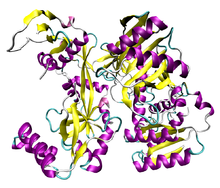Argonaute
| Argonaute Piwi domain | |||||||||
|---|---|---|---|---|---|---|---|---|---|

An argonaute protein from Pyrococcus furiosus. PDB 1U04. PIWI domain is on the right, PAZ domain to the left.
|
|||||||||
| Identifiers | |||||||||
| Symbol | Piwi | ||||||||
| Pfam | PF02171 | ||||||||
| InterPro | IPR003165 | ||||||||
| PROSITE | PS50822 | ||||||||
| CDD | cd02826 | ||||||||
|
|||||||||
| Available protein structures: | |
|---|---|
| Pfam | structures |
| PDB | RCSB PDB; PDBe; PDBj |
| PDBsum | structure summary |
| Argonaute Paz domain | |||||||||
|---|---|---|---|---|---|---|---|---|---|
| Identifiers | |||||||||
| Symbol | Paz | ||||||||
| Pfam | PF12212 | ||||||||
| InterPro | IPR021103 | ||||||||
| SCOP | b.34.14.1 | ||||||||
| SUPERFAMILY | b.34.14.1 | ||||||||
|
|||||||||
| Available protein structures: | |
|---|---|
| Pfam | structures |
| PDB | RCSB PDB; PDBe; PDBj |
| PDBsum | structure summary |
The Argonaute protein family plays a central role in RNA silencing processes, as essential components of the RNA-induced silencing complex (RISC). RISC is responsible for the gene silencing phenomenon known as RNA interference (RNAi). Argonaute proteins bind different classes of small non-coding RNAs, including microRNAs (miRNAs), small interfering RNAs (siRNAs) and Piwi-interacting RNAs (piRNAs). Small RNAs guide Argonaute proteins to their specific targets through sequence complementarity (base pairing), which then leads to mRNA cleavage or translation inhibition.
The RNA interference (RNAi) was first reported in 1995 by Guo and Kemphues, and similar pathways collectively referred to as RNA silencing were discovered in plants and fungi. The beginning of people’s understanding of the mechanism of RNA silencing began only in 1998 with the experiments of Fire and colleagues demonstrating that double-stranded RNA triggered RNAi. RNA silencing pathways process long RNAs into small RNAs that direct the repression of transcription or translation of nucleic acid targets with sequence corresponding to the small RNAs. These single-stranded RNAs, referred to as guide strands, are incorporated into RNA silencing effectors complexes such as the RNA-induced silencing complex (RISC). These RNA silencing effector complexes contain Argonaute family proteins.
RNA interference (RNAi) is a biological process in which the RNA molecules inhibit gene expression. The method of inhibition is via the destruction of specific mRNA molecules or by simply suppressing the protein translation. The RNA interference has a significant role in defending cells against parasitic nucleotide sequences. In many eukaryotes, including animals, the RNA interference pathway is found, and it is initiated by the enzyme Dicer. Dicer cleaves long double-stranded RNA molecules into short double stranded fragments of around 20 nucleotide siRNAs. The dsRNA is then separated into two single-stranded RNAs (ssRNA) - the passenger strand and the guide strand. Consequently, the passenger strand is degraded, while the guide strand is incorporated into the RNA-induced silencing complex (RISC). The most well-studied outcome of the RNAi is post-transcriptional gene silencing, which occurs when the guide strand pairs with a complementary sequence in a messenger RNA molecule and induces cleavage by Argonaute, that lies in the core of RNA-induced silencing complex.
...
Wikipedia
